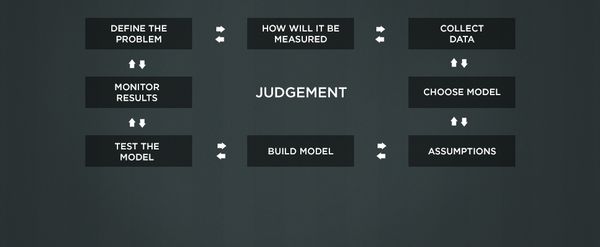How do you build a sports betting model? What steps are involved? What do you need to consider? Follow these steps to build your own quantitative model, and take your betting to the next level.

What is a betting model?
In it’s simplest form a sports betting model is a system that can identify unbiased reference points from where you can determine the probability for all outcomes in a particular game.
The model will ultimately be able to highlight profitable betting opportunities, by judging a team’s true ability more accurately than a bookmaker.
However, building a sports betting model can be difficult and time consuming. There are various instructions and orders advised for you to follow when creating a model, which can complicate the process.
With that said, once you have created a successful betting model it can show you opportunities that the general betting public simply wouldn’t consider.
Let’s begin.
For this example we use an approach similar to the Actuarial Control Cycle – a quantitative risk assessment employed by insurance companies. There are five main features:
- Defining the problem
- Building the solution
- Monitoring results
- Professionalism
- External forces
Step 1: Specify the aim of your betting model
This appears simple, but many sports bettors miss the point their betting model is trying to accomplish.
Without an aim you could be overwhelmed with numbers and lose focus of your overall goals.
Although you may argue you can get the data first to see if there are any patterns, this would still need to be tested against a number of hypothesis, each with a different aim.
Therefore starting with a specific, rather than a generic aim, is strongly recommended.
Step 2: Select the metric
The next step is to formalise your investigation into numerical form by selecting a quantifiable metric.
These first two steps relate to defining the problem stage of the Actuarial Control Cycle.
Step 3: Collect, group and modify data
Every model needs data so you can integrate it into your algorithm. There are two ways of collecting data – by yourself, or by using other published data online.
Luckily, there is a plethora of data available on the Internet, some of which is free, while some websites offer a paid service.
Once you have the data, you may realise that there are queries that need to be taken care of.
If we are looking at Premier League teams for instance, should you consider all matches or just their league games? It’s possible to make adjustments if the team in question had players missing, or had a mid-week Champions’ League clash.
This is where you can exercise your judgement, determined by what your aim is.
Step 4: Choosing the form of your model
This is where the mathematics comes into play given there are so many models to choose from or invent.
We have proposed a number of models in the past and they can be as complex or as simple as you wish. Our recommendation is not to overcomplicate.
This step can be interchanged with step 3 as the data may lead you to use a particular model, or a particular model may require specific data.
Step 5: Dealing with assumptions
Each model will have a number of assumptions, and you should be aware of their limitations. You may forget to do this, but it’s absolutely vital.
For example a significant contributor to the financial crisis in 2007-08 was the misuse of derivatives caused by a misunderstanding of assumptions in contracts such as Collateralised Debt Obligations and Credit Default Swaps.
Previously in this article we highlighted how averages and standard deviations assume events are normally distributed. This for example would need be tested.
Step 6: Build the sports betting model
The next step is to actually build the sports betting model. There are numerous tools to use including online calculators, Excel, MatLab, Java, R programming and VBA.
You don’t have to be a wiz at programming to build a sports betting model, but the more you understand the functionality, the better equipped you will become when testing and analysing the data.
Step 7: Test the model
It’s paramount that you test the efficiency of any sports betting model to understand how sensitive it is to the results.
In any case the results of the model may lead us to reconsider any of the previous steps.
The key question as always is whether or not the model is making a profit? Therefore you’d need to test that – leading you to running through the cycle again.
Step 8: Monitor results
Assuming that an adequate model has been built and tested, it needs to be maintained as time progresses. This leads us back to the starting point – defining future aims.
Applied knowledge
Understanding the processes involved is paramount when learning how to build a sports betting model.
Quantitative modelling isn’t just about taking a model and applying it, there are a number of processes – not necessarily in the order stated – which should be completed.
Following this process won’t guarantee a profit-making model, but it will ensure you are considering the fundamental aspects that are needed to build a new sports betting model.
For an example of how to build a betting model, click here.
Dominic Cortis is a lecturer with the Department of Mathematics at The University of Leicester; and an assistant lecturer at The University of Malta. He is an associate actuary and his research focuses on sports analytics as well as financial and betting derivatives.
MORE: TOP 100 Online Bookmakers >>>
MORE: TOP 20 Bookmakers that accept U.S. players >>>
MORE: TOP 20 Bookmakers that accept Cryptocurrency >>>
Source: pinnacle.com
